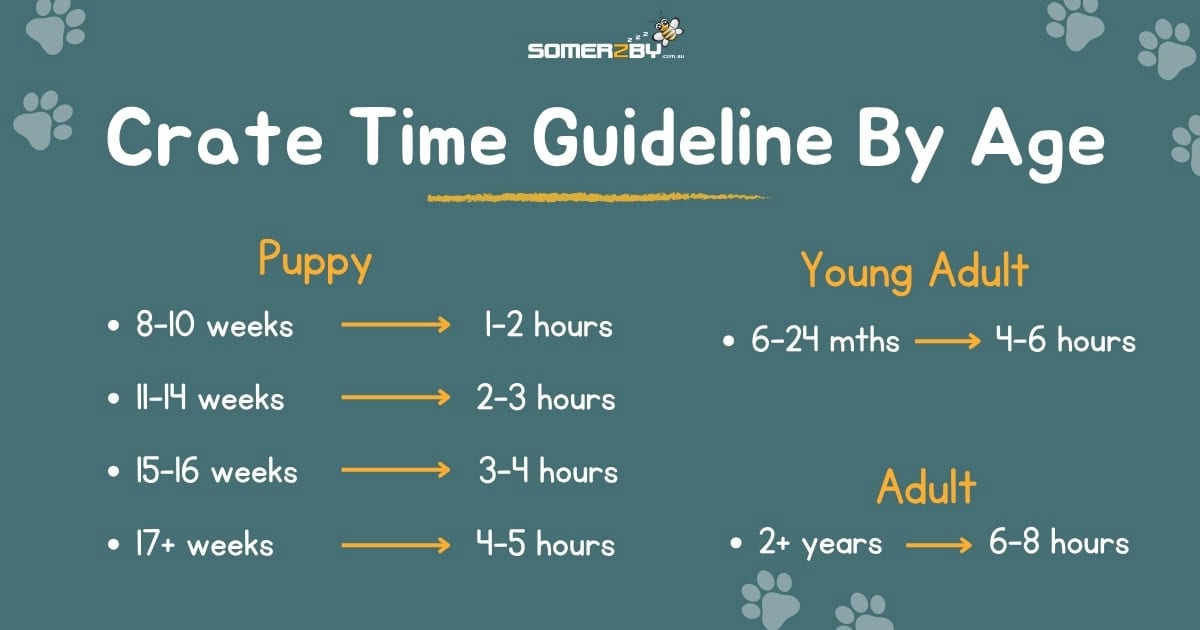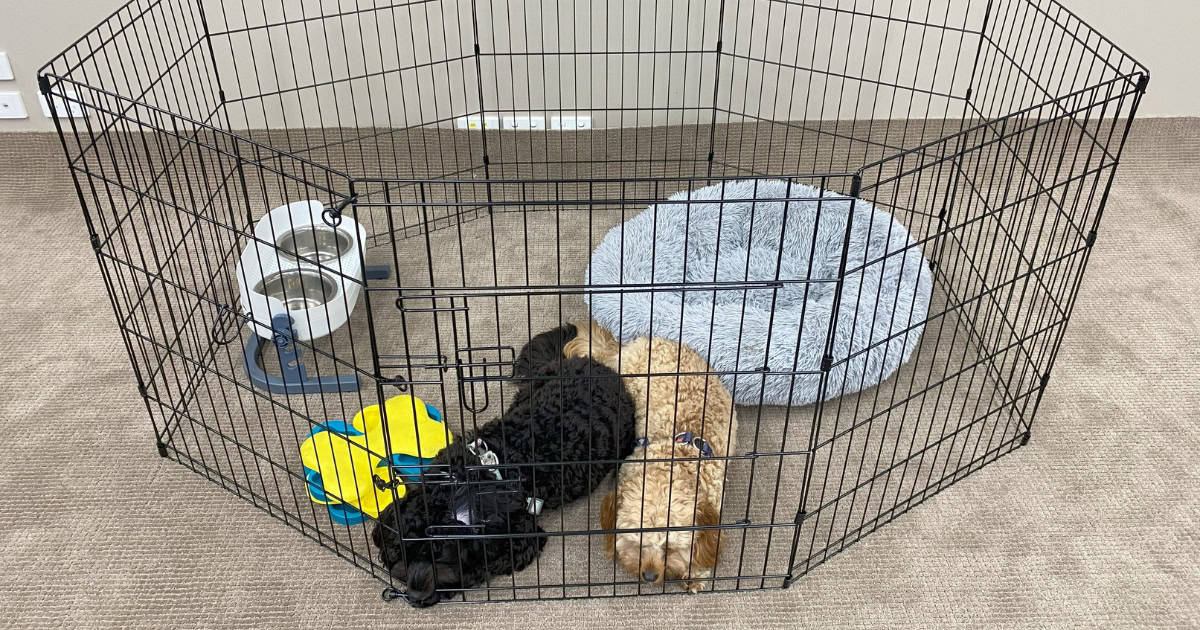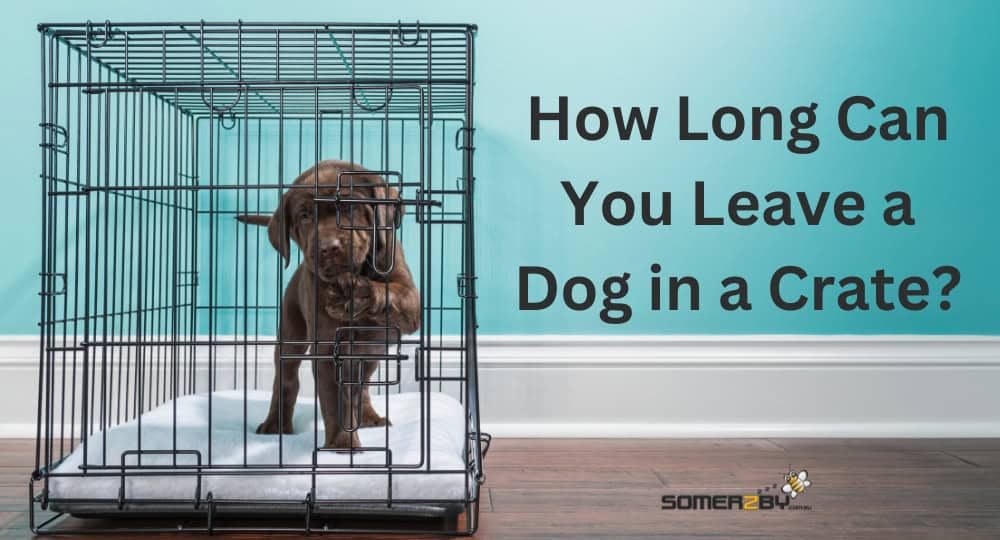As a dog owner, you’ve probably wondered: How long can you leave a dog in a crate? It’s a common question and the truth is, there’s no one-size-fits-all situation. The ideal crate time depends on several factors including age, health, temperament, individual needs, and previous crate training experience.
This guide explores how long dogs can stay in a crate and offers practical advice to help your pup stay comfortable and well-cared for.
Key Takeaways:
-
Crate time depends on age, health, and training experience.
-
A puppy’s maximum crate time is calculated based on their age in months plus one, in hours.
-
Adult dogs should be crated for a maximum of 6–8 hours.
-
Time spent in the crate should be balanced with exercise, play, toilet breaks, and interaction.
-
When away for long periods, use puppy-proofed spaces, dog walkers, or daycare as alternatives.
Understanding the Purpose of Crate Training
Crate training is a valuable and effective tool for both you and your dog. When used with the crate door closed, crates provide a safe, den-like space for your dog to feel secure and calm.
Crates can assist with house training by encouraging bladder control and providing structure. They also help prevent destructive behaviour when unsupervised. That said, you don’t always have to keep the crate door closed. Many dogs enjoy having the crate open and will happily wander in on their own to relax or take a nap. Remember that a crate should never be used as punishment!

Guidelines for Crate Time by Age
Puppies (8-16 weeks)
Puppies this young should only be crated for 1 to 3 hours at a time. They need frequent potty breaks, along with lots of playtime, social interaction, and rest.
Young Adult Dogs (6 months – 2 years)
As your dog grows, they can usually handle being in a crate for 4 to 6 hours at a time. But they’re still full of energy and curiosity, so regular breaks for walks, play, and bathroom trips are really important to keep them happy and healthy.
Adult Dogs (2+ years)
Most healthy adult dogs can handle staying in a crate for 6 to 8 hours. That said, just because they can doesn’t mean they should be crated that long every day. They still need daily exercise, interaction, and time to stretch their legs to stay happy and well-balanced.
Every dog is different, but here are some general guidelines based on age.
|
Dog’s Age |
Maximum Crate Time |
Notes |
|
8-10 weeks |
1-2 hours |
Frequent potty breaks are required |
|
11-14 weeks |
2-3 hours |
Still developing bladder control |
|
15-16 weeks |
3-4 hours |
Slightly improved bladder control |
|
17+ weeks |
4-5 hours |
Gradually increase time in the crate |
|
Adult (2+ years) |
6-8 hours |
Manageable with enough daily exercise and attention |

Factors Affecting How Long a Dog Can Stay in a Crate
Age and Development Stage
Puppies have much less bladder control than adult dogs. A general rule for having puppies stay in a crate is: Puppy’s age in months + 1 = Maximum hours in a crate. For example, a 2-month-old puppy shouldn’t be crated for more than 3 hours at a time.
Health and Physical Condition
Senior dogs or those with medical issues may need frequent bathroom breaks. A dog’s energy level also matters; active breeds like Border Collies may struggle spending time in a crate for long periods, while more laid-back breeds like Bulldogs often tolerate it better. Consult your vet if you’re unsure how long your dog can be crated.
Previous Crate Training Experience
Dogs familiar with being crated often associate crating with comfort and routine, making them more likely to tolerate longer periods. On the other hand, dogs new to crates may feel anxious or restless and need a slower introduction to help build that positive association.
The Importance of Exercise and Mental Stimulation
When considering how long you can leave a dog in a crate, it’s important to balance the time spent in a crate with plenty of exercise and mental stimulation. Physical and mental activity helps burn off excess energy, making it easier for your dog to settle and rest comfortably. Without this outlet, dogs may feel trapped or anxious.
Before any extended crate time, be sure to take your dog for a walk or engage in a play session. This not only tires them out but also gives them a chance to relieve themselves, reducing the risk of accidents.
Alternatives to Extended Crate Time
Crates can be really helpful, but regularly leaving your dog in the crate for long periods isn’t ideal. If you’re often away or your schedule doesn’t allow for frequent breaks, here are some more flexible, dog-friendly alternatives:

Puppy-Proofed Area
Instead of a crate, try setting up a safe, puppy-proofed space in your home. This could be a small room, a gated-off area, or even a large playpen where your puppy has room to move around. Adding a comfortable bed, water, and puzzle toys that hide small food treats will keep them entertained and mentally stimulated while you’re out.
Pet Sitters or Dog Walkers
If you’re away for most of the day, hiring a pet sitter or dog walker can make a big difference. A quick visit in the middle of the day gives your dog a chance to go to the toilet, stretch their legs, and enjoy some company, helping break up long hours alone.
Doggy Daycare
For social or high-energy dogs, doggy daycare is a great option. It gives them a full day of play, socialisation, and mental stimulation while you’re at work. It’s especially helpful for active breeds such as Australian Shepherds and Labradors.
These alternatives can reduce the time your dog spends in a crate and help prevent boredom, frustration, and destructive behaviours.
Tips for Successful Crate Training
To make crate time a positive experience for your dog, consider these tips for crate training success:
-
-
Choose the right sized crate. It should be large enough for your dog to stand up, turn around, and lie down comfortably.
-
Make the crate inviting and comfortable. Add bedding, soft blanket and a few toys to create a cosy den.
-
Introduce the crate gradually. Use positive reinforcement techniques like treats and praise.
-
Never use the crate as punishment. This can create negative associations with the crate.
-
Provide plenty of exercise and attention when your dog is not in the crate. This balances their crate time.
-

FAQs
Is it okay to leave my dog in a crate while at work?
No. While dogs can technically be crated for up to 8 hours per day, we do not recommend crating your dog for a full workday. Puppies shouldn’t be left in a crate longer than recommended, as they need more frequent potty breaks and interaction. Make sure your dog gets exercise before and after and consider a midday break or alternatives like a dog walker or daycare if you are regularly away for long hours.
How long is too long to leave a dog in a crate?
Anything over 8 hours is usually too long for an large dog to be crated, especially every day. Puppies and older dogs need even more frequent breaks. Too much time in a crate can lead to boredom, stress, or even bladder infections from having to ‘hold it’, so it’s important to mix in plenty of walks, play time, and human interaction.
Can I crate my dog for 12 hours?
No, crating a dog for 12 hours isn’t recommended. That’s a long time without a potty break, movement, or interaction. If you need to be away that long, consider the option of doggy daycare to help break up the day and keep your dog happy and healthy.
What is caged dog syndrome?
When a dog is confined to a crate or kennel for long periods, with very limited social interaction or exercise, caged dog syndrome occurs. Symptoms can include depression, anxiety, aggression, and loss of house training. It’s important to use crates responsibly to avoid these issues and ensure training success.
Toni’s Wrap
Understanding how long you can leave a dog in a crate is an important part of responsible pet ownership. Crates can be incredibly useful for training, transportation and short-term management, but they shouldn’t be a long-term solution. Balancing crate time with exercise, mental stimulation, and social interaction is essential for your dog’s overall wellbeing.
Remember, every dog is different. What works for one may not work for another. Pay close attention to your dog’s needs and behaviours, and adjust your routine as needed. With the right balance of structure, activity and positive reinforcement, your dog can feel safe, happy and well adjusted in and out of the crate.




